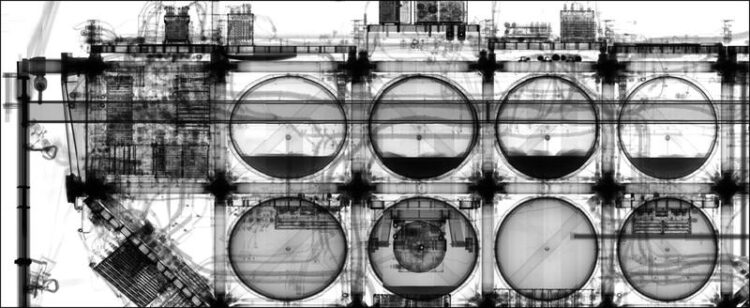Accurate analysis of 3D-printed components

X-ray tomography image of the EURECA satellite (size about 3m x 6m x 3m), which orbited the Earth from 1992 to 1993. The satellite is now on display at the Swiss Museum of Transport.
Image: Empa
Together with scientists from the Paul Scherrer Institute (PSI), X-ray specialists from Empa are now providing their industrial partners with access to state-of-the-art material analysis of 3D-printed work pieces and components. For this purpose, Empa has recently become a member of the technology transfer center ANAXAM in Villigen.
The membership in the technology transfer center ANAXAM, initiated in 2019 by PSI, the University of Applied Sciences Northwestern Switzerland (FHNW), the Swiss Nanoscience Institute (SNI) and the Canton of Aargau, fosters on the one hand the exchange of experience among researchers in the growing field of Additive Manufacturing (AM). Above all, however, stat-of-the-art analytical equipment is now available to industrial partners – an important factor in staying ahead in quality control in 3D printing.
X-ray tomography for heavy and light parts
Three Empa devices in particular should be of interest to developers of 3D printing solutions. In the Linac high-energy X-ray tomograph, which is particularly suitable for large components, work pieces up to 70 centimeters in diameter and up to 2 meters high can be analyzed. The X-rays penetrate steel up to 35 centimeters in thickness. X-ray images of specimens made of reinforced concrete are also possible with this device.
On the other side of the scale is the RX X-ray tomograph, which can produce images with a resolution of 0.6 micrometers. This means that even the smallest material defects can be detected. Empa’s phase-contrast X-ray equipment is particularly well-suited for lightweight materials, such as plastic components, which show only low contrasts in X-ray light. Thanks to a special analysis of the scattered X-rays, this new method can achieve resolutions down to one micrometer.
The instruments available at Empa’s X-ray Center are complemented by the Empa Platform for Image Analysis, which uses sophisticated image processing methods to make the information in the two- and three-dimensional X-ray scans accessible. And with training courses for experts from industry, Empa scientists make sure the analytical methods are used safely and effectively.
Expertise for industry
The ANAXAM technology transfer center is part of the Advanced Manufacturing Technology Transfer Center (AM-TTC) alliance, which Empa helped to establish. The AM-TTC initiative is a measure in the Federal Government’s Action Plan on Digitization of the State Secretariat for Education, Research and Innovation (SERI) to promote innovation and accelerate knowledge transfer.
Wissenschaftliche Ansprechpartner:
Dr. Robert Zboray
Center for X-ray Analytics
Tel. +41 58 765 46 02
robert.zboray@empa.ch
Weitere Informationen:
https://www.empa.ch/web/s604/anaxam Empa Media release
https://www.anaxam.ch/de ANAXAM Network
Media Contact
All latest news from the category: Materials Sciences
Materials management deals with the research, development, manufacturing and processing of raw and industrial materials. Key aspects here are biological and medical issues, which play an increasingly important role in this field.
innovations-report offers in-depth articles related to the development and application of materials and the structure and properties of new materials.
Newest articles

Properties of new materials for microchips
… can now be measured well. Reseachers of Delft University of Technology demonstrated measuring performance properties of ultrathin silicon membranes. Making ever smaller and more powerful chips requires new ultrathin…

Floating solar’s potential
… to support sustainable development by addressing climate, water, and energy goals holistically. A new study published this week in Nature Energy raises the potential for floating solar photovoltaics (FPV)…

Skyrmions move at record speeds
… a step towards the computing of the future. An international research team led by scientists from the CNRS1 has discovered that the magnetic nanobubbles2 known as skyrmions can be…





















